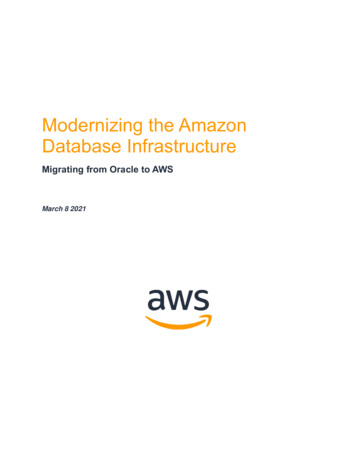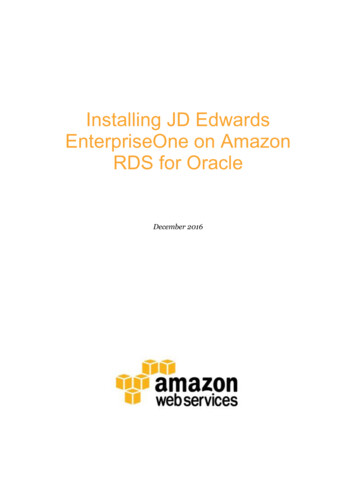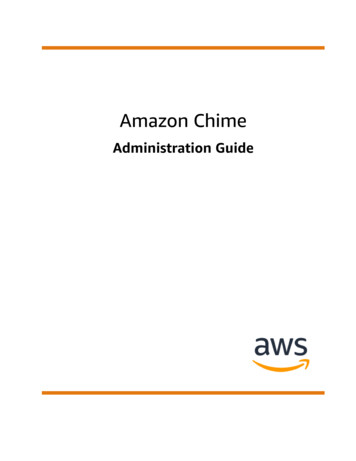
Transcription
Modernizing the AmazonDatabase InfrastructureMigrating from Oracle to AWSMarch 8 2021
NoticesCustomers are responsible for making their own independent assessment of theinformation in this document. This document: (a) is for informational purposes only, (b)represents current AWS product offerings and practices, which are subject to changewithout notice, and (c) does not create any commitments or assurances from AWS andits affiliates, suppliers or licensors. AWS products or services are provided “as is”without warranties, representations, or conditions of any kind, whether express orimplied. The responsibilities and liabilities of AWS to its customers are controlled byAWS agreements, and this document is not part of, nor does it modify, any agreementbetween AWS and its customers. 2021 Amazon Web Services, Inc. or its affiliates. All rights reserved.
ContentsOverview .1Challenges with using Oracle databases .1Complex database engineering required to scale .1Complex, expensive, and error-prone database administration .2Inefficient and complex hardware provisioning .2AWS Services .2Purpose-built databases .2Other AWS Services used in implementation .4Picking the right database.4Challenges during migration .5Diverse application architectures inherited.5Distributed and geographically dispersed teams .6Interconnected and highly interdependent services.6Gap in skills .6Competing initiatives .7People, processes, and tools .7People.7Processes and mechanisms .8Tools .11Common migration patterns and strategies.11Migrating to Amazon DynamoDB – FLASH .11Migration to Amazon DynamoDB – Items and Offers .18Migrating to Aurora for PostgreSQL – Amazon Fulfillment Technologies (AFT) .25Migrating to Amazon Aurora – buyer fraud detection .32Organization-wide benefits.36Post-migration operating model .37
Distributed ownership of databases .37Career growth .37Contributors .38Document revisions .38
AbstractThis whitepaper is intended to be read by existing and potential customers interested inmigrating their application databases from Oracle to open-source databases hosted onAWS. Specifically, the paper is for customers interested in migrating their Oracledatabases used by Online Transactional Processing (OLTP) applications to AmazonDynamoDB, Amazon Aurora, or open-source engines running on Amazon RDS.The whitepaper draws upon the experience of Amazon engineers who recently migratedthousands of Oracle application databases to Amazon Web Services (AWS) as part of alarge-scale refactoring program. The whitepaper begins with an overview of Amazon’sscale and the complexity of its service-oriented architecture and the challenges ofoperating these services on on-premises Oracle databases. It covers the breadth ofdatabase services offered by AWS and their benefits. The paper discusses existingapplication designs, the challenges encountered when moving them to AWS, themigration strategies employed, and the benefits of the migration. Finally, it sharesimportant lessons learned during the migration process and the post-migrationoperating model.The whitepaper is targeted at senior leaders at enterprises, IT decision makers,software developers, database engineers, program managers, and solutions architectswho are executing or considering a similar transformation of their enterprise. The readeris expected to have a basic understanding of application architectures, databases, andAWS.
Amazon Web ServicesModernizing the Amazon Database InfrastructureOverviewThe Amazon consumer facing business builds and operates thousands of services tosupport its hundreds of millions of customers. These services enable customers toaccomplish a range of tasks such as browsing the Amazon.com website, placing orders,submitting payment information, subscribing to services, and initiating returns. Theservices also enable employees to perform activities such as optimizing inventory infulfillment centers, scheduling customer deliveries, reporting and managing expenses,performing financial accounting, and analyzing data. Amazon engineers ensure that allservices operate at very high availability, especially those that impact the customerexperience. Customer facing services are expected to operate at over 99.90%availability leaving them with a very small margin for downtime.In the past, Amazon consumer businesses operated data centers and managed theirdatabases distinct from AWS. Prior to 2018, these services used Oracle databases fortheir persistence layer which amounted to over 6,000 Oracle databases operating on20,000 CPU cores. These databases were hosted in tens of data centers on-premises,occupied thousands of square feet of space, and cost millions of dollars to maintain. In2017, Amazon consumer facing entities embarked on a journey to migrate thepersistence layer of all these services from Oracle to open-source or license-freealternatives on AWS. This migration was completed to leverage the cost effectiveness,scale, and reliability of AWS and also to break free from the challenges of using Oracledatabases on-premises.Challenges with using Oracle databasesAmazon recently started facing a growing number of challenges with using Oracledatabases to scale its services. This section briefly describes three of the most criticalchallenges faced.Complex database engineering required to scaleEngineers spent hundreds of hours each year trying to scale the Oracle databaseshorizontally to keep pace with the rapid growth in service throughputs and datavolumes. Engineers used database shards to handle the additional service throughputsand manage the growing data volumes but in doing so increased the databaseadministration workloads. The design and implementation of these shards werecomplex engineering exercises with new shards taking months to implement and test.1
Amazon Web ServicesModernizing the Amazon Database InfrastructureSeveral services required hundreds of these shards to handle the required throughputplacing an exceptionally high administrative burden on database engineers anddatabase administrators.Complex, expensive, and error-prone databaseadministrationThe second challenge was dealing with complicated, expensive, and error-pronedatabase administration. Database engineers spent hundreds of hours each monthmonitoring database performance, upgrading software, performing database backups,and patching the operating system (OS) for each instance and shard. This activity wastedious, and it had the potential to cause downtime and trigger a cascade of failures.Inefficient and complex hardware provisioningThe third challenge was dealing with complex and inefficient hardware provisioning.Each year database engineers and the infrastructure management team expendedsubstantial time forecasting demand and planning hardware capacity to meet it. Afterforecasting, engineers spent hundreds of hours purchasing, installing, and testing thehardware in multiple data centers around the world. Additionally, teams had to maintaina sufficiently large pool of spare infrastructure to fix any hardware issues and performpreventive maintenance. These challenges coupled with the high licensing costs werejust some of the compelling reasons for the Amazon consumer and digital business tomigrate the persistence layer of all its services to cloud native or open-sourcedatabases hosted on AWS.AWS ServicesThis section provides an overview of the key AWS database Services used by Amazonengineers to host the persistence layer of their services. It also briefly describes otherimportant AWS Services used by Amazon engineers as part of this transition.Purpose-built databasesAmazon expects all its services be globally available, operate with microsecond tomillisecond latency, handle millions of requests per second, operate with near zerodowntime, cost only what is needed, and be managed efficiently. AWS services meetthese requirements by offering a range of purpose-built databases thereby allowingAmazon engineers to focus on innovating for their customers.2
Amazon Web ServicesModernizing the Amazon Database InfrastructureRange of databases offered by AWSAmazon’s engineers relied on three key database services to host the persistence layerof their services—Amazon DynamoDB, Amazon Aurora, and Amazon RDS forMySQL or PostgreSQL.Amazon DynamoDBAmazon DynamoDB is a key-value and document database that delivers single-digitmillisecond performance at any scale. It is a fully managed, multi-region database withbuilt-in security, backup and restore, and in-memory caching for internet-scaleapplications. Amazon DynamoDB service can handle trillions of requests per day andeasily support over double-digit millions of requests per second across its entirebackplane. You can start small or large and DynamoDB will automatically scale capacityup and down as needed.Amazon AuroraAmazon Aurora is a MySQL and PostgreSQL compatible relational database built forthe cloud that combines the performance and availability of traditional enterprisedatabases with the simplicity and cost-effectiveness of open-source databases. AmazonAurora is up to five times faster than standard MySQL databases and three times fasterthan standard PostgreSQL databases. It provides the security, availability, and reliabilityof commercial databases at 1/10th the cost.3
Amazon Web ServicesModernizing the Amazon Database InfrastructureAmazon Relational Database Service (Amazon RDS) for MySQL orPostgreSQLAmazon RDS is a database management service that makes it easier to set up,operate, and scale a relational database in the cloud. It provides cost-efficient, resizablecapacity for an industry-standard relational database and manages common databaseadministration tasks.Other AWS Services used in implementationAmazon engineers also the following additional services in the implementation:Amazon Simple Storage Service (Amazon S3): An object storage service that offersindustry-leading scalability, data availability, security, and performance.AWS Database Migration Service: A service that helps customers migrate databases toAWS quickly and securely. The source database remains fully operational during themigration, minimizing downtime to applications that rely on the database. The AWSDatabase Migration Service can migrate data to and from most widely used commercialand open-source databases.Amazon Elastic Compute Cloud (Amazon EC2): A web service that provides secure,resizable compute capacity in the cloud designed to make web-scale cloud computingeasier.Amazon EMR: A service that provides a managed Apache Hadoop framework thatmakes it easy, fast, and cost-effective to process vast amounts of data acrossdynamically scalable Amazon EC2 instances.AWS Glue: A fully managed extract, transform, and load (ETL) service that makes iteasy for customers to prepare and load their data for analytics.Picking the right databaseDue to the wide range of purpose-built databases offered by AWS, each team couldpick the most appropriate database based on scale, complexity, and features of itsservice. This approach was in stark contrast to the earlier use of Oracle databaseswhere the service was modified to use a monolithic database layer. The followingsection describes the decision-making process used to pick the right persistence layerfor a service.4
Amazon Web ServicesModernizing the Amazon Database InfrastructureAmazon engineers ran preliminary analysis on their database query and usage patternsand discovered that 70% of their workloads used single key-value operations that hadlittle use for the relational features that their Oracle databases were offering. Theaccess pattern for another 20% of the workloads was limited to a single table. Only 10%of the workloads used features of relational databases by accessing data acrossmultiple keys. This discovery implied that most services were better served through aNoSQL store such as Amazon DynamoDB. Amazon DynamoDB offers superiorperformance at high throughputs and consumes less storage for sparse or semistructured data sets than relational databases. Given the benefits of using AmazonDynamoDB, engineers running critical, high-throughput services decided to migratetheir persistence layer to it.Business units running services that use relatively static schemas, perform complextable lookups, and experience high service throughputs picked Amazon Aurora.Amazon Aurora provides the security, availability, and reliability of commercialdatabases at a fraction of their cost; and is fully managed by Amazon RelationalDatabase Service (Amazon RDS) which automates tasks like hardware provisioning,database setup, patching, and backups.Lastly, business units using operational data stores that had moderate read and writetraffic, and relied on the features of relational databases selected Amazon RDS forPostgreSQL or MySQL for their persistence layer. Amazon RDS offers the choice of ondemand pricing with no up-front or long-term commitments or Reserved Instance pricingat lower rates—flexibility that was not previously available with Oracle. Amazon RDSfreed up these business units to focus on operating their services at scale withoutincurring excessive administrative overhead.Challenges during migrationThe following section highlights key challenges faced by Amazon during thetransformation journey. It also discusses mechanisms employed to successfullyovercome these challenges and their outcomes.Diverse application architectures inheritedSince its inception, Amazon has been defined by a culture of decentralized ownershipthat offered engineers the freedom to make design decisions that would deliver value totheir customers. This freedom proliferated a wide range of design patterns andframeworks across teams. In parallel, the rapid expansion of the capabilities of AWS5
Amazon Web ServicesModernizing the Amazon Database Infrastructureallowed the more recent services to launch cloud-native designs. Another source ofdiversity was infrastructure management and its impact on service architectures. Teamsneeding granular control of their database hardware operated autonomous data centerswhereas others relied on shared resources. This created the possibility of teamsoperating different versions of Oracle in a multitude of configurations. This diversitydefied standard, repeatable migration patterns from Oracle to AWS databases. Thearchitecture of each service had to be evaluated and the most appropriate approach tomigration had to be determined.Distributed and geographically dispersed teamsAmazon operates in a range of customer business segments in multiple geographieswhich operate independently. Managing the migration program across this distributedworkforce posed challenges including effectively communicating the program vision andmission, driving goal alignment with business and technical leaders across thesebusinesses, defining and setting acceptable yet ambitious goals for each business units,coordinating across a dozen time zones, and dealing with conflicts.Interconnected and highly interdependent servicesAs described in the overview section, Amazon operates a vast set of microservices thatare interconnected and use common databases. To illustrate this point, the item maindatabases maintain information about items sold on the Amazon website including itemdescription, item quantity, and item price. This database, its replicas, and the servicewere frequently accessed by dozens of other microservices and ETLs. A single servicelosing access to the database could trigger a cascade of customer issues leading tounforeseen consequences. Migrating interdependent and interconnected services andtheir underlying databases required finely coordinated movement between teams.Gap in skillsAs Amazon engineers used Oracle databases, they developed expertise over the yearsin operating, maintaining, and optimizing them. As most of these databases werehosted on-premises, the engineers also gained experience in maintaining these datacenters and managing specialty hardware. Most service teams shared databases thatwere managed by a shared pool of database engineers and the migration to AWS wasa paradigm shift for them as they did not have expertise in: Open-source database technologies such as PostgreSQL or MySQL6
Amazon Web ServicesModernizing the Amazon Database Infrastructure AWS native databases such as Amazon DynamoDB or Amazon Aurora NoSQL data modeling, data access patterns, and how to use them effectively Designing and building services that are cloud nativeCompeting initiativesLastly, each business unit was grappling with competing initiatives. In certain situations,competing priorities created resource conflicts that required intervention from the seniorleadership.People, processes, and toolsThe previous section discussed a few of the many challenges facing Amazon during themigration journey. To circumvent these challenges, Amazon’s leadership decided toinvest significant time and resources to build a team, establish processes andmechanisms, and develop tooling to accelerate the intended outcomes. The followingthree sections discuss how three levers—people, processes, and tools—were engagedto drive the project forward.PeopleOne of the pillars of success was founding the Center of Excellence (CoE). The CoEwas staffed with experienced enterprise program managers who led enterprise-wideinitiatives at Amazon in the past. The leadership team ensured that these programmanagers had a combination of technical knowledge and program managementcapabilities. This unique combination of skills ensured that the program managers couldconverse fluently with software developers and database engineers about the benefitsof application architectures and also engage with business leaders across geographiesand business units to resolve conflicts and ensure alignment.Key objectivesThe key objectives of the CoE were: Define the overall program vision, mission and goals Define the goals for business units and service teams Define critical milestones for each service team and tracking progress againstthem7
Amazon Web ServicesModernizing the Amazon Database Infrastructure Ensure business units receive resources and support from their leadership Manage exceptions and project delays Uncover technical and business risks, exposing them, and identifying mitigationstrategies Monitor the health of the program and preparing progress reports for seniorleadership Engage with the information security audit teams at Amazon to ensure that allAWS services meet data protection requirements Publish configurations for each AWS service that meets these data protectionrequirements; and perform audits of all deployments Schedule training for software developers and database engineers by leveragingSMEs from a variety of subject areas Identify patterns in issues across teams and engage with AWS product teams tofind solutions Consolidate product feature requests across teams and engage with AWSproduct teams to prioritize themProcesses and mechanismsThis section elaborates on the processes and mechanisms established by the CoE andtheir impact on the outcome of the project.Goal setting and leadership reviewThe program managers in the CoE realized early in the project that the migration wouldrequire attention from senior leaders. To enable them to track progress, manage delays,and mitigate risks the program managers established a monthly project review cadence.They used the review meeting to highlight systemic risks, recurrent issues, andprogress. This visibility provided the leadership an opportunity to take remedial actionwhen necessary. The CoE also ensured that all business segments prioritized themigration.Establishing a hub-and-spoke modelDue to the large number of services, teams, and geographical locations that were partof the project, the CoE realized that it would be arduous and cumbersome to individually8
Amazon Web ServicesModernizing the Amazon Database Infrastructuretrack the status of each migration. Therefore, they established a hub-and-spoke modelwhere service teams nominated a team member, typically a technical programmanager, who acted as the spoke and the CoE program managers were the hub.The spokes were responsible for: Preparing project plans for their teams Submitting these project plans to the CoE and receiving validation Tracking progress against this plan and reporting it Reporting major delays or issues Seeking assistance from the CoE to address recurrent issuesThe hubs were responsible for: Validating the project plans of individual teams for accuracy and completeness Preparing and maintaining a unified database/service ramp down plan Maintaining open communications with each spoke to uncover recurrent issues Assisting service teams that require help Preparing project reports for leadership and escalate systemic risksTraining and guidanceA key objective for the CoE was to ensure that Amazon engineers were comfortablemoving their services to AWS. To achieve this, it was essential to train these teams onopen source and AWS native databases, and cloud-based design patterns. The CoEachieved this by Scheduling training sessions on open-source and AWS native databases Live streaming training sessions for employees situated in different time zones Scheduling design review sessions and workshops between subject matterexperts and service teams facing roadblocks Scheduling tech talks with AWS product managers on future roadmaps Connecting teams encountering similar challenges through informal channels toencourage them to share knowledge9
Amazon Web Services Modernizing the Amazon Database InfrastructureDocumenting frequently encountered challenges and solutions in a centralrepositoryEstablishing product feedback cycles with AWSIn the spirit of customer obsession, AWS constantly sought feedback from Amazonengineers. This feedback mechanism was instrumental in helping AWS rapidly test andrelease features to support internet scale workloads. This feedback mechanism alsoenabled AWS to launch product features essential for its other customers operatingsimilar sized workloads.Establishing positive reinforcementIn large scale enterprise projects, engineers and teams can get overwhelmed by thevolume and complexity of work. To ensure that teams make regular progress towardsgoals, it is important to promote and reinforce positive behaviors, recognize teams, andcelebrate their progress. The CoE established multiple mechanisms to achieve this,including the following initiatives: Broadcasting the success of teams that met program milestones and goals Opening communication channels between software developers, databasesengineers, and program managers to share ideas and learnings Ensuring that the leaders on all teams were recognized for making progressRisk management and issue trackingEnterprise scale projects involving large numbers of teams across geographies arebound to face issues and setbacks. The CoE discovered that managing these setbackseffectively was crucial to project success. The following key mechanisms were used bythe CoE to manage issues and setbacks: Diving deep into issues faced by teams to identify root cause of issues Support these teams with the right resources and expertise by leverage AWSsupport Ensure setbacks receive leadership visibility for remedial action Documenting these patterns in issues and their solutions Disseminating these learnings across the company10
Amazon Web ServicesModernizing the Amazon Database InfrastructureToolsIn the spirit of frugality, the CoE wanted to achieve more with minimal resources. Due tothe complexity of the project management process, the CoE decided to invest in toolsthat would automate the project management and tracking. Tooling was built to Track active Oracle instances hosted in data centers Track the activity of these instances and understand data flow using SQLactivity Tag databases to teams and individuals that own them; and synchronize thisinformation with the HR database Track and manage database migration milestones using the tool in a singleportal Prepare project status reports by aggregating the status of every service teamTo meet these requirements, the CoE developed a web application tool that connects toeach active Oracle instance, gathers additional information about it including objectsand operations performed, and then displays this information to users through a webbrowser. The tool also allowed users to communicate project status, prepare statusreports and manage exception approvals. It enhanced transparency, improvedaccountability, and automated the tedious process of tracking databases and theirstatus, marking a huge leap in productivity for the CoE.Common migration patterns and strategiesThe following section describes the migration journey of four systems used in Amazonfrom Oracle to AWS. This section also provides insight on design challenges andmigration strategies to enable readers to perform a similar migration.Migrating to Amazon DynamoDB – FLASHOverview of FLASHAmazon operates a set of critical services called the Financial Ledger and AccountingSystems Hub (FLASH). FLASH services enable various business entities to postfinancial transactions to Amazon’s sub-ledger. It supports four categories oftransactions compliant with Generally Accepted Accounting Principles (GAAP)—account receivables, account payables, remittances, and payments. FLASH aggregates11
Amazon Web ServicesModernizing the Amazon Database Infrastructurethese sub-ledger transactions and populates them to Amazon’s general ledger forfinancial reporting, auditing, and analytics. Until 2018, FLASH used 90 Oracledatabases, 183 instances, and stored over 120 terabytes of data. FLASH used thelargest available Oracle-certified single instance hardware.Data flow diagram of FLASHChallenges with operating FLASH services on OracleAs evident, FLASH is a high-throughput, complex, and critical system at Amazon. Itexperienced many challenges while operating on Oracle databases.Poor latencyThe first challenge was poor service latency despite having performed extensivedatabase optimization. The service latency was degrading every year due to the rapidgrowth in service throughputs.Escalating database costsThe second challenge related to yearly escalating database hosting costs. Each year,the database hosting costs were growing by at least 10%, and the FLASH team wasunable to circumvent the excessive database administration overhead associated withthis growth.Difficult to achieve scaleThe third challenge was negotiating the complex interdependencies between FLASHservices when attempting to scale the system. As FLASH used a monolithic Oracledatabase service, the interdependencies between the various components of theFLASH system were preventing efficient scaling of the system.These challenges encouraged the FLASH team to migrate the persistence layer of itsservices to AWS and rearchitect the APIs to use more efficient patterns.12
Amazon Web ServicesModernizing the Amazon Database InfrastructureReasons to choose Amazon DynamoDB as the persistence layerAmong the range of database services offered by AWS, the FLASH engineers pickedAmazon DynamoDB. The key reasons that the FLASH team picked DynamoDB follow.Easier to scaleAs DynamoDB can scale to handle trillions of requests per day and can sustain millionsof requests per second, it was the ideal choice to handle the high throughput
Amazon Relational Database Service (Amazon RDS) for MySQL or PostgreSQL Amazon RDS is a database management service that makes it easier to set up, operate, and scale a relational database in the cloud. It provides cost-efficient, resizable capacity for an industry-standard relational database and manages common database administration tasks.




![Index [beckassets.blob.core.windows ]](/img/66/30639857-1119689333-14.jpg)





